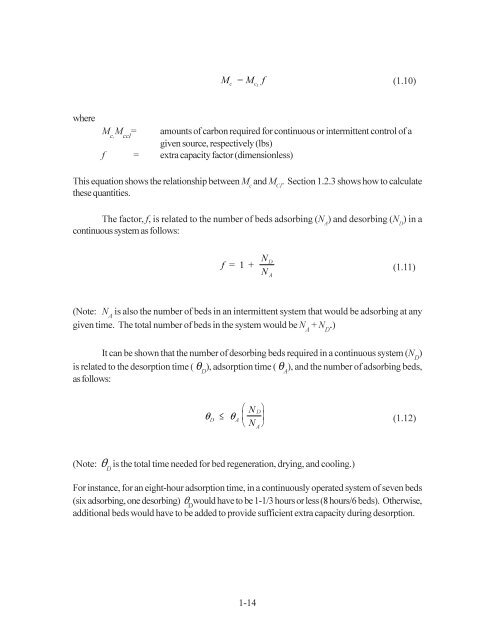Section 3 VOC Controls - US Environmental Protection Agency
Section 3 VOC Controls - US Environmental Protection Agency
Section 3 VOC Controls - US Environmental Protection Agency
Create successful ePaper yourself
Turn your PDF publications into a flip-book with our unique Google optimized e-Paper software.
where<br />
M = M f<br />
c c I (1.10)<br />
M c, M ccI = amounts of carbon required for continuous or intermittent control of a<br />
given source, respectively (lbs)<br />
f = extra capacity factor (dimensionless)<br />
This equation shows the relationship between M c and M CI . <strong>Section</strong> 1.2.3 shows how to calculate<br />
these quantities.<br />
The factor, f, is related to the number of beds adsorbing (N A ) and desorbing (N D ) in a<br />
continuous system as follows:<br />
f<br />
ND<br />
= 1 +<br />
N<br />
(1.11)<br />
(Note: N A is also the number of beds in an intermittent system that would be adsorbing at any<br />
given time. The total number of beds in the system would be N A + N D .)<br />
It can be shown that the number of desorbing beds required in a continuous system (N D )<br />
is related to the desorption time ( θ D ), adsorption time ( θ A ), and the number of adsorbing beds,<br />
as follows:<br />
⎛ N<br />
θD ≤ θA<br />
⎜<br />
⎝ N<br />
1-14<br />
D<br />
A<br />
A<br />
⎞<br />
⎟ (1.12)<br />
⎠<br />
(Note: 2 D is the total time needed for bed regeneration, drying, and cooling.)<br />
For instance, for an eight-hour adsorption time, in a continuously operated system of seven beds<br />
(six adsorbing, one desorbing) 2 D would have to be 1-1/3 hours or less (8 hours/6 beds). Otherwise,<br />
additional beds would have to be added to provide sufficient extra capacity during desorption.

















